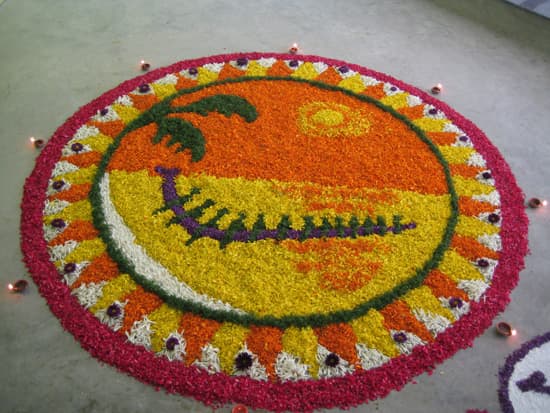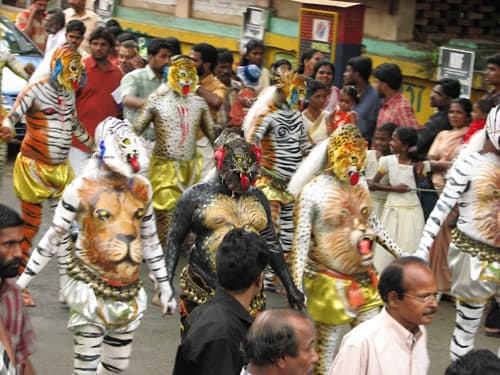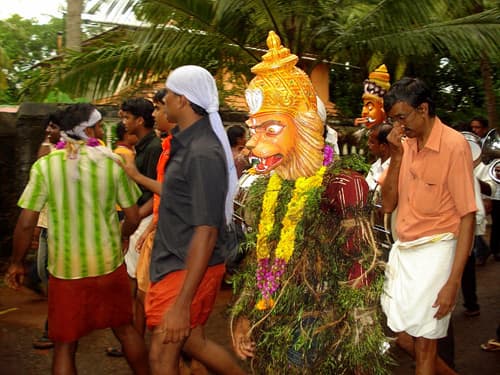The Onam Festival In Kerala
Onam, though a Hindu festival, is celebrated with equal fervor among all the religions and communities in South India. Being the most important festival of the state, Keralites from all over the world, rush to their near and dear ones in the state to enjoy this special season with them. Those who are not able to travel to their families, make the best of the festivals with the limited resources they have at wherever they live.
An introduction to Onam
Onam, the biggest festival of Kerala is celebrated with a huge pomp and show during the month of Chingam (August-September). Coming right after Karkkidakam (called the month of starvation or poverty), Chingam is the month where there is abundance all around. Farmers enjoy a full harvest and there is food on the plate. This abundance is celebrated and hence Onam is known as the harvest festival of South India, mainly Kerala. The main festival falls on Thriuvonam, the day when the people of Kerala welcome their ancient and beloved King Mahabali, who as the legend goes, comes to visit them on that day. Thirvonam is celebrated by preparing Ona Sadya or the great feast comprising of several sumptuous main dishes, rice, four types of curries, pappadams, and several kinds of payasam. The feast is followed by Onam songs and games. The people of Kerala join in the festivals irrespective of their financial condition, and remember to don new dresses, known as Onakkodi. They believe in splurging on that particular day even if they have to live in poverty for the rest of the year.
About the great Asura, Mahabali
India is a land of diverse cultures and beliefs, but when Onam draws near, they forget their differences and come together to welcome the most loved king of all time – King Mahabali. Though an Asura (demon), Mahabali was a righteous and generous king who loved his subjects and ruled wisely and judiciously. He was so great a king that the gods felt jealous, and even threatened by his rising popularity. The mother of gods, Aditi visited Lord Vishnu in his abode and told him about the king in Kerala who was becoming more popular than the gods themselves. Lord Vishnu, who resides in the ‘Ksheerasagar’ or the Milky Way decided to test Mahabali’s righteousness and generosity, and thus assumed the form of a small boy called Vamana and approached Mahabali. Mahabali, being the righteous king that he was welcomed the Lord with great joy and even readily accepted the demand of the Lord. The Lord demanded three paces of ground from the king. Unfortunately, though righteous and honest, Mahabali was quite ego-centric and the unsuspicious king readily accepted the demand and agreed to give into the Lord’s demand. The Lord rose to a height of great proportions and towered above the heavens. He completed the earth and sky with two strides. When Mahabali saw that the Lord had no more place to place this third stride, he requested the Lord to place His foot on his head. The Lord, placing His foot on Mahabali’s head pushed the great king into the bowels of the earth. But not before granting a boon requested by Mahabali. The request was this – He wished to return to earth once a year to visit his people. The genesis of Onam is that the great king makes his annual visit during every Onam.
Festivities during Onam
Keralites celebrate Onam with great vigor, because for them it is a festival that reflects the faith that they still have about their beliefs. Being the biggest festival of Kerala, the preparations start 10 days ago, with people adorning the front porch of their houses with pookalam (decoration/carpet of flowers). The pookalam is put every day for 10 days, and the preparations begin on Attham.
Kerala is a beautiful land with luscious fields, scintillating trees, glistening backwaters, mystery-invoking forests and mesmerizing beaches. During the month of Onam, the beauty of Kerala is enhanced even further, because you can see lots of happy faces around, especially those of the farmers when they behold the sweet fruits of their labor on the fields.
The cultural extravaganza of Kerala during the 10 days of celebration is internationally renowned. It is heartwarming to watch the team spirit and unity of people in the following festivals:
The main Onam dances are
Pulikkali
This is a 200 year old art where people smear themselves with black and yellow paint to create the semblance of tiger, and the person with the largest paunch is the most successful “puli”
Kathakali
A dance drama with elaborate costumes, plenty of music and interesting stories from Hindu mythology
Kaikottikali
A unique dance form with eight to ten performers moving rhythmically around intricately designed flower carpets at the center of which you have a brass lamp
Thumbi Thullal
A colorful spectacle with women dressed in all their glory and splendor with a lead performer and repeat performers
Onam games
Talappanthukali
This is a ball game where men are involved; the ball however is made of dried up plantain leaf
Kummatti kali
Where performers adorn colorful masks and go from house to house entertaining people and collecting small gifts for the same
Kayyankali
Is heavy physical combat between men and many may even get hurt
Ambeyyal
Players are formed into two teams and they perform archery; it is also a relatively dangerous game
Kutukutu
A fun game and very much like Kabbadi
Onam sadya
Onam is incomplete without the famed Ona sadya where a grand feast is prepared on the day of “Thiruvonam”. The feast is prepared and served in families so when Mahabali comes to visit his people, he would be happy to see that his people are all happy and prosperous as was during his time. Onam feast used to comprise of 64 mandatory dishes served on banana leaf, complete with pappadams, payasams, banana wafers, sharkkarapuratti fries and pickles. Here are the names of some of the dishes served during the feast – Rice, Erisseri, Kalan or Pulisseri, Aviyal, Olan, Thoran, Mulakoshyam, Koottukari, Pachchati, Kichchati, Rasam, Parippu and Sambar.
Interesting links about the topic:
Onam Celebration In Kerala
kerala’s Onam Festival
Pictures: Flickr.com/ Praveen/ Francis/ Radhakrishnan/ Joseph TI

The author: Reema Oamkumar is engaged as a thought leader at Software-Developer-India.com which is a part of the YUHIRO Group. YUHIRO is a German-Indian enterprise which provides programmers to IT companies, agencies and IT departments.




